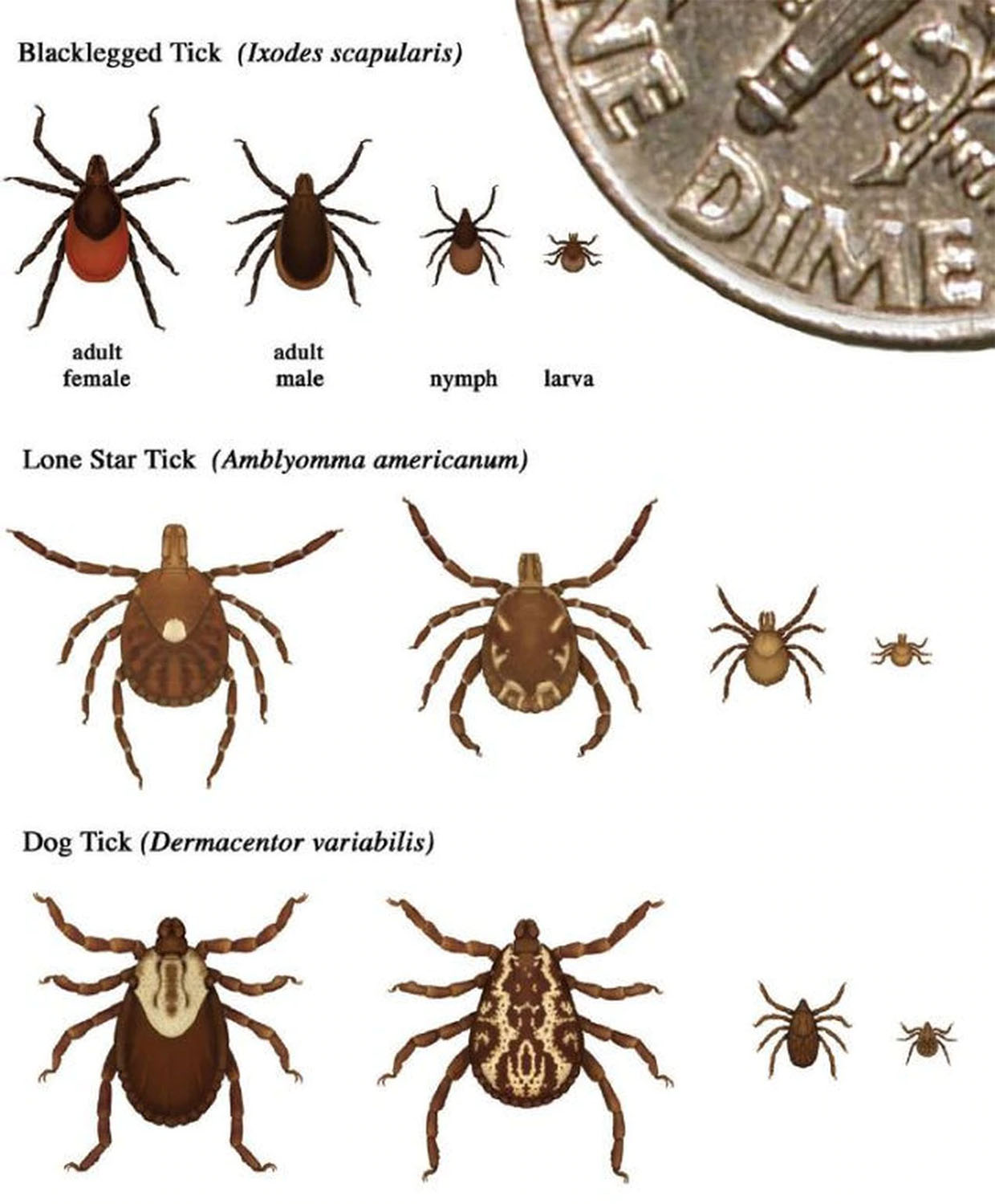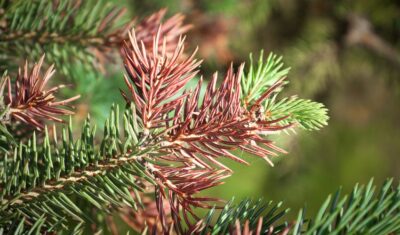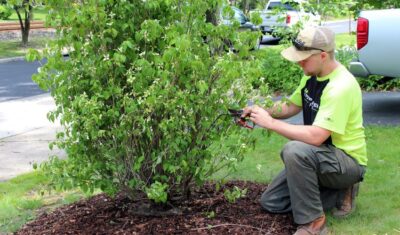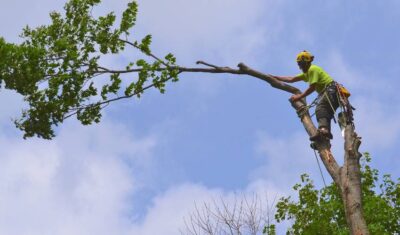Ticks are showing up more often in Northeast Ohio and you may be affected by them. The threat of tick bites can make spending time outdoors less attractive, and when your yard or garden may be the only green space you can spend time in it’s important that you feel comfortable in it.
Don’t let the fear of ticks dictate your enjoyment of your garden—strike back by protecting yourself when outdoors and keeping them off your property with natural, low-toxicity tick spray treatments. Read on to learn more about ticks, their danger to humans, and what to do about them.
Do ticks bite people?
If you’ve ever had a pet that spends time outside, you have probably found a tick in their fur. Dogs, cats, horses—all can get ticks. But they don’t stop there – ticks bite a range of warm-blooded animals, including us. We like to be out of doors in warm weather when ticks are active, and we have gardens that make attractive homes for ticks (and other pests).
Why are ticks a concern?
Diseases spread by ticks are an increasing concern in Ohio and are being reported to the Ohio Department of Health more frequently in the past decade, with Lyme disease and Rocky Mountain spotted fever (RMSF) being the most common. Other tickborne diseases such as anaplasmosis, babesiosis, and ehrlichiosis are also on the rise. Though rare, diseases such as tularemia, southern tick-associated rash illness (STARI) and Powassan virus may also be carried by ticks in Northeast Ohio.
Which ticks are found in Northeast Ohio?
Although there are 12 species of ticks that have been found in Ohio, not all carry diseases that can be transmitted to humans. In our part of Northeast Ohio, there are three disease-carrying ticks that you should be on the lookout for:
- American Dog Tick – Dermacentor variabilis is its Latin name, and open, grassy areas throughout Ohio are its game. Females of this species are the ones that bite, and they can transmit Rocky Mountain Spotted Fever.
- Blacklegged Tick – Ixodes scapularis, also known as the deer tick, is tiny and found in many of Ohio’s counties. It’s become more common in Northeast counties, particularly in brushy, wooded areas. This tick can carry and spread Lyme disease, anaplasmosis, babesiosis and Powassan virus disease.
- Lonestar Tick – Ambylomma americanum is the most aggressive of these ticks and the most likely to bite humans. They are found on squirrels, deer, cattle, and domestic pets, and live in woodland areas with brush or undergrowth. While their range has been mainly in the southern part of Ohio, their range is expanding. These ticks carry and can transmit Ehrlichiosis to humans.
Ticks have been found – and people have been bitten by them – in Cuyahoga, Geauga, Lake, Portage, Summit, and all surrounding counties in Ohio. If you haven’t seen one yet, it’s just a matter of time.

The 3 ticks that transmit nearly all diseases in northeast Ohio are tiny, especially in their immature stage.
When are ticks active in Northeast Ohio?
Ticks like the same warm months that we like to be outside, often with our pets. While some ticks, such as the black-legged (or deer) tick, can be active nearly all year round in one stage or another, most encounters with ticks occur in spring through mid-summer and again in fall.
The Lyme disease-carrying deer tick becomes active in late March or early April, although peak activity is between May and June and again in October to early November. You’re most likely to encounter the American Dog Tick and Lone Star ticks between April and September.
How can I avoid getting bitten by a tick?
There are several ways that you can reduce the likelihood that you will be bitten by ticks.
To prevent ticks from biting, you should always:
- Spray your clothing and gear with repellent to discourage ticks from crawling on you. If you use DEET, make sure its concentration is high enough to repel ticks. Permethrin, which is used to treat clothes like pants, socks, and shoes (do not spray it on skin!) kills ticks on contact.
- Wear long sleeves and boots when you’re outside hiking or playing.
- Tuck your pant legs into your socks.
- After hiking or playing in areas where ticks can hide, remove your clothing before entering the house.
- Check yourself, or have someone check you, for crawling or attached ticks.
- Check your pet’s fur for ticks daily and make sure household pets wear a tick collar. If you have a dog, Lyme disease vaccinations are available.
What should I do if I’ve been bitten by a tick?
First, remember that if a tick isn’t carrying any diseases, it can bite you and not transmit disease. You’ll still want to avoid ticks, but finding one shouldn’t immediately make you think the worst.
If you find a tick on yourself, remove it as quickly as possible. The video below shows you how to remove a tick safely using tweezers.
Monitor yourself for signs of a rash, fever, or other flu-like symptoms. If any of these symptoms occur, you should contact your healthcare provider.
The Ohio Department of Health does not recommend getting a tick tested to see if it’s carrying a transmissible disease. Not all ticks carry diseases. But if the tick that bit you does have a disease, waiting for test results will delay any needed treatment. It’s also likely that if you’ve found one tick, you’ve also received bites from other ticks; if the tested tick is negative for disease, you may still have contracted a disease through a separate tick bite.
For more information about what to do after a tick bite in Ohio, see the Ohio Department of Health website.
How can I keep ticks away from my house?
Along with your personal protection, you can also make modifications to your outdoor spaces to provide yourself with the greatest protection from ticks.
Ticks need a host (such as you, a bird, rodent, or deer) to attach to or jump off of, so make your property less of a place for ticks to hang around in. Seriously! Ticks hang out on tall grasses (but not a well-mowed lawn), plants, and twigs to wait for a passing victim that they grab onto. It’s called “questing” but it’s not a quest you want to go on.
Ticks are sensitive to changes in their environment, especially exposure and dryness. By following these suggestions, you can make your garden less attractive to ticks:
- Mow your lawn regularly, instead of letting it grow long between mowing
- Avoid overwatering any areas of your garden, as most ticks want moisture and not dryness
- Keep weeds, brush, and leaf litter cleared from around your lawn
- Mulch a three foot-wide wood chip path around your lawn, woodpile, and stone walls to make a tick barrier between your garden and overgrown, grassy, or brushy areas beyond
- Remove brush, weeds, and debris from around stone walls and woodpiles, where both ticks and rodents can hide
- Move birdfeeders and woodpiles that attract birds and rodents away from the outdoor areas where you and your pets spend time
- Keep areas around your house clear and open to sunlight and air by pruning back shrubs and tree branches
- Locate children’s play areas and equipment away from grassy, brushy, or overgrown areas, and use a layer of wood chip mulch as a play surface (ticks don’t make their homes in wood chips)
- Don’t grow garden plants that attract deer, or fence off areas to keep deer out
Are there any resources where I can learn more about ticks?
Yes! Many government organizations, states, and counties have put together excellent websites with both national and local information about ticks. Here are some of the sites we recommend –
- The Centers for Disease Control and Prevention has complete information on ticks and the diseases they can transmit to you.
- Cuyahoga County Board of Health
- Ohio Department of Health has a whole section about tickborne diseases in Ohio
- Ohio State University Extension has a very informative page about ticks and tickborne diseases
What are the best practices for tick control?
Many common garden insects such as ants, spiders, and beetles eat ticks. Encouraging these natural garden predators is a good idea, so get rid of those traditional pesticides that kill every insect indiscriminately and follow the best practices listed above.
If you live in an area with many deer, are unable to take the preventive measures described above, or have health concerns, then we can help keep your garden safe with our natural tick control spray program that keeps the ticks away. We have regular spraying schedules and can add you to our route. Give us a call at 440-564-1374 to find out more or to schedule an appointment!
Protect Your Family From Ticks & Mosquitoes
The incidence of tick- and mosquito-borne diseases is rising across northeast Ohio. The best option is to kill these pests before they become a problem. Preventive treatments applied on a regular schedule offer effective control to keep you, your family, and your pets safe. Call us today at 440-564-1374 for your free tick and mosquito control consultation or use the online form and we'll call you back.Recent Articles
Topics
About The Author

STAY IN THE LOOP
WITH OUR
LATEST UPDATES
"*" indicates required fields







